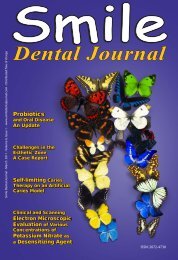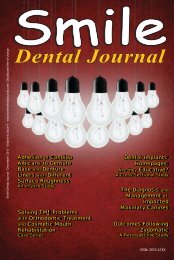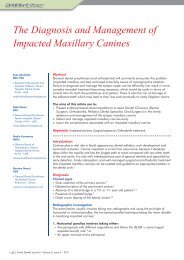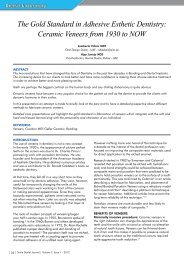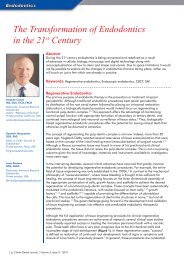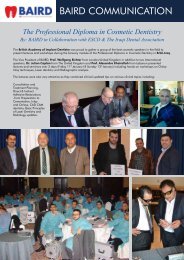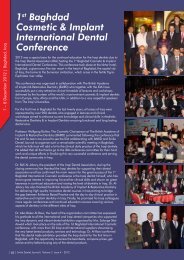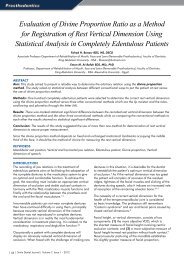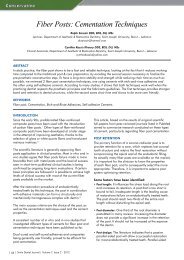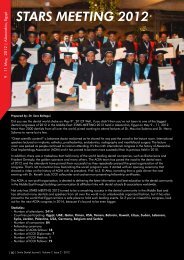Download e-copy - Smile Dental Journal
Download e-copy - Smile Dental Journal
Download e-copy - Smile Dental Journal
You also want an ePaper? Increase the reach of your titles
YUMPU automatically turns print PDFs into web optimized ePapers that Google loves.
(Fig. 4) Cross sectional slices showing position of<br />
supernumerary tooth between 14-15.<br />
(Fig. 5) Cross sectional slices showing palatal position of<br />
supernumerary tooth between 24-25.<br />
(Fig. 6) Axial slice – Two supernumerary teeth in the lower<br />
right side.<br />
(Fig. 7) Cross sectional slices showing position of<br />
supernumerary tooth between 45-46.<br />
(Fig. 8) Cross sectional slices showing position of<br />
supernumerary tooth lingual to 44.<br />
(Fig. 9) Cross sectional slices showing lingual position of<br />
supernumerary teeth between 34-35.<br />
(Fig. 10) Cross sectional slices showing position of<br />
supernumerary teeth between 35-36, presenting coronal<br />
radiolucency.<br />
Because displacements, rotation, ectopic eruption,<br />
and malocclusion can be the result of maintaining<br />
supernumerary teeth in the mouth, a clinical and<br />
radiographic examination is essential for a good<br />
orthodontic treatment planning. 15<br />
Treatment may be difficult and may vary from just<br />
extraction of supernumerary teeth or extraction<br />
followed by orthodontic correction to establish a good<br />
occlusion. 16,17<br />
In this case, it was decided to extract all the erupted and<br />
unerupted supernumerary teeth besides the orthodontic<br />
treatment.<br />
Based upon the supernumerary teeth classification, this<br />
reported case presented the parapremolars position type<br />
along with both supplemental and tuberculate shape.<br />
Conclusion<br />
Non syndromatic multiple supernumerary teeth is a very<br />
rare anomaly that appears usually in the lower premolar<br />
region.<br />
In this case report, the patient presented supplementary<br />
and tuberculate teeth in four quadrants of his mouth.<br />
The use of a cone beam imaging technique is essential<br />
during any pre-orthodontic assessment in order to<br />
evaluate the situation and number of the supernumerary<br />
teeth with all possible details, in three planes (axial,<br />
coronal and sagittal views), irrespective of whether the<br />
patient has any syndrome or not.<br />
References<br />
1. Ezddini AF, Sheikha MH. Prevalence of dental developmental<br />
anomalies: A radiographic study. Community Dent Health<br />
2007;24:140-4<br />
2. Leco Berrocal MI, Martín Morales JF, Martínez González JM. An<br />
observational study of the frequency of supernumerary teeth in<br />
a population of 2000 patients. Med Oral Patol Oral Cir Bucal.<br />
2007;12(2):E134-8.<br />
3. Açikgöz A, Açikgöz G, Tunga U, Otan F. Characteristics and<br />
prevalence of non-syndrome multiple supernumerary teeth: a<br />
retrospective study. Dentomaxillofac Radiol. 2006;35(3):185-90.<br />
4. Peker I, Kaya E, Darendeliler-Yaman S. Clinic and radiographical<br />
evaluation of non-syndromic hypodontia and hyperdontia<br />
in permanent dentition. Med Oral Patol Oral Cir Bucal.<br />
2009;14(8):393-7.<br />
5. Yagüe-García J, Berini-Aytés L, Gay-Escoda C. Multiple<br />
supernumerary teeth not associated with complex syndromes:<br />
a retrospective study. Med Oral Patol Oral Cir Bucal.<br />
2009;14(7):331-6.<br />
6. Rajab LD, Hamdan MAM. Supernumerary teeth: a review<br />
of the literature and a survey of 152 cases. Int Pediatr Dent.<br />
2002;12:244-54.<br />
7. Hyun HK, Lee SJ, Ahn BD, Lee ZH, Heo MS, Seo BM, Kim JW.<br />
Nonsyndromic multiple mandibular supernumerary premolars. J<br />
Oral Maxillofac Surg. 2008;66(7):1366-9.<br />
8. Giancotti A, Grazzini F, De Dominicis F, Romanini G, Arcuri<br />
Multidisciplinary evaluation and clinical management of<br />
mesiodens. J Clin Pediatr Dent. 2002;26:233-7.<br />
9. Srivatsan P, Aravindha Babu N. Mesiodens with an unusual<br />
morphology and multiple impacted supernumerary teeth in a nonsyndromic<br />
patient. Indian J Dent Res. 2007;18(3):138-40.<br />
10. Asaumi JI, Shibata Y, Yanagi Y, Hisatomi M, Matsuzaki H, Konouchi<br />
H, Kishi K. Radiographic examination of mesiodens and their<br />
associated complications. Dentomaxillofac Radiol. 2004;33:125-7.<br />
11. Suprabha BS, Sumanth KN, Boaz K, George T. An unusual case of<br />
non-syndromic occurrence of multiple dental anomalies. Indian J<br />
Dent Res. 2009;20(3):385-7.<br />
12. Scheiner MA, Sampson WJ. Supernumerary teeth: a review of the<br />
literature and four case reports. Aus Dent J. 2007;42:160-5.<br />
13. Varela M, Arrieta P, Ventureira C. Non-syndromic concomitant<br />
hypodontia and supernumerary teeth in an orthodontic population.<br />
Eur J Orthod. 2009;31(6):632-7.<br />
14. Yusof WZ. Non-syndrome multiple supernumerary teeth: literature<br />
review. J Can Dent Assoc. 1990;56:147-9.<br />
15. Mason C, Rule DC, Hopper C. Multiple supernumeraries: the<br />
importance of clinical and radiographic follow-up. Dentomaxillofac<br />
Radiol. 1996;25:109-13.<br />
16. Díaz A, Orozco J, Fonseca M. Multiple hyperodontia: report of a<br />
case with 17 supernumerary teeth with non syndromic association.<br />
Med Oral Patol Oral Cir Bucal. 2009;14(5):229-31.<br />
17. Sivapathasundharam B, Einstein A. Non-syndromic multiple<br />
supernumerary teeth: report of a case with 14 supplemental teeth.<br />
Indian J Dent Res. 2007;18(3):144.<br />
| 14 | <strong>Smile</strong> <strong>Dental</strong> <strong>Journal</strong> | Volume 5, Issue 4 - 2010 <strong>Smile</strong> <strong>Dental</strong> <strong>Journal</strong> | Volume 5, Issue 4 - 2010 | 15 |



